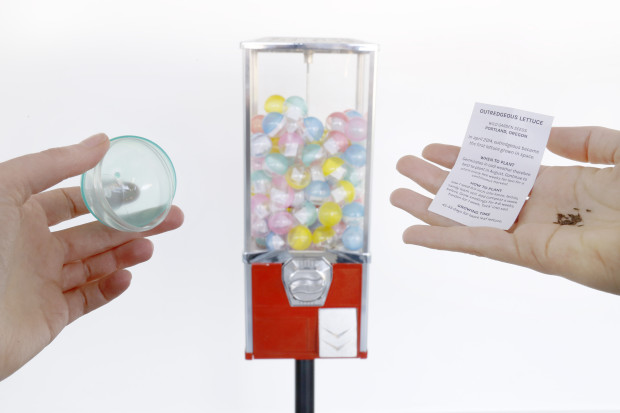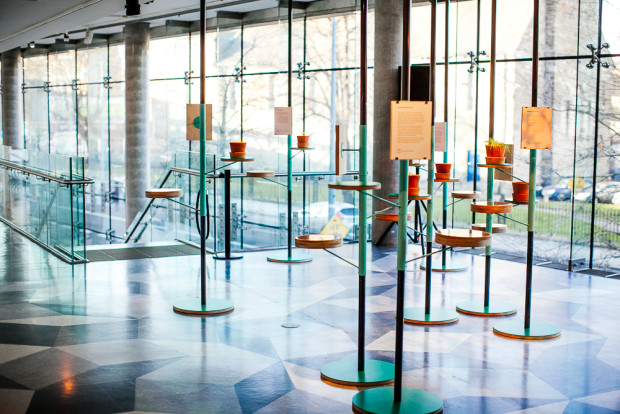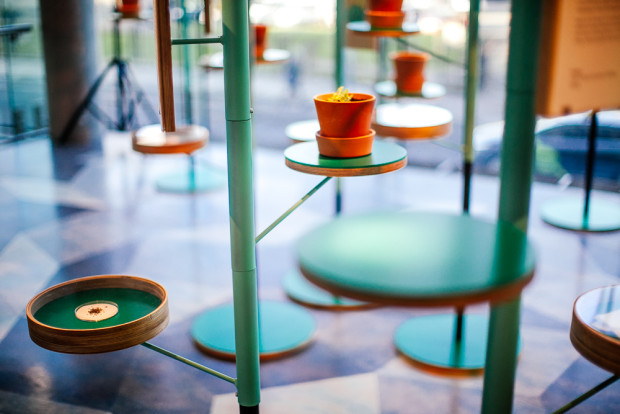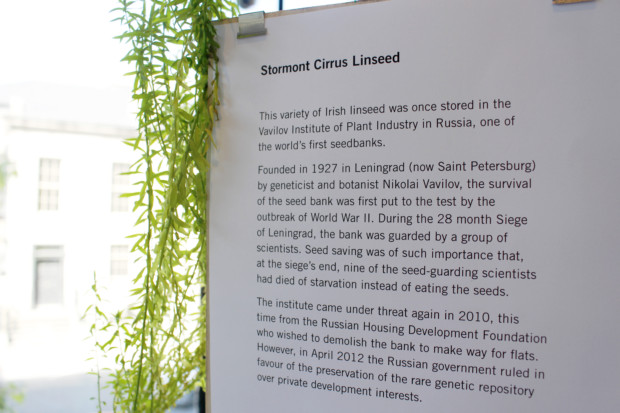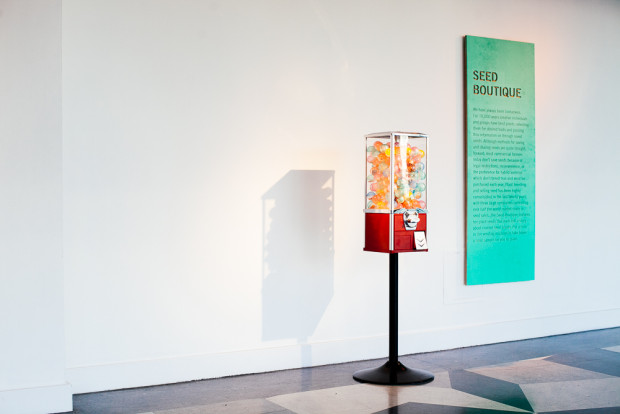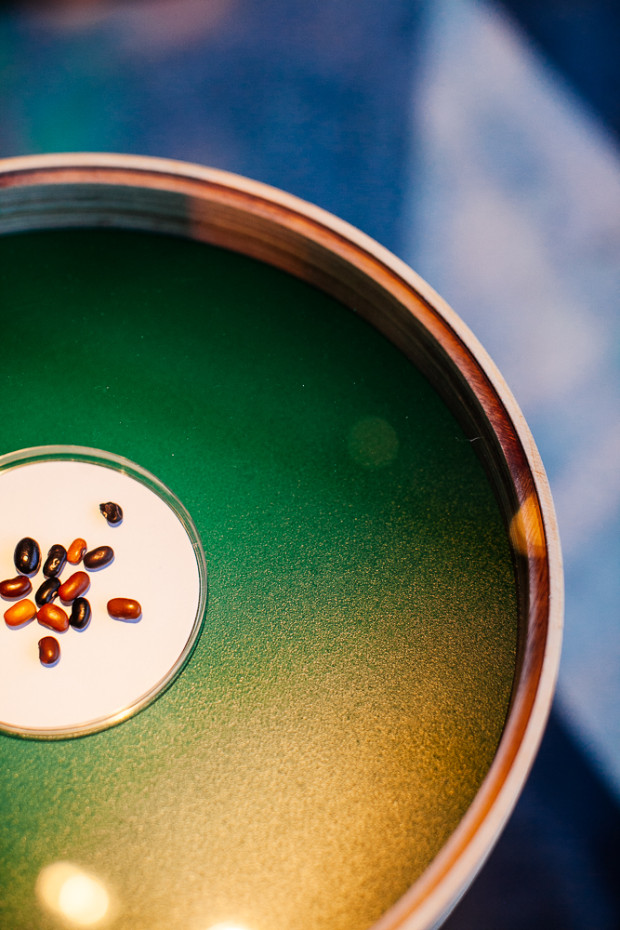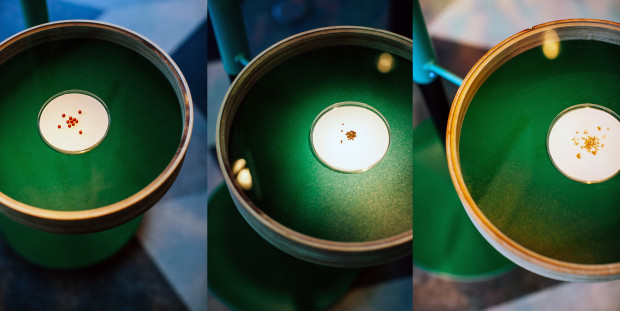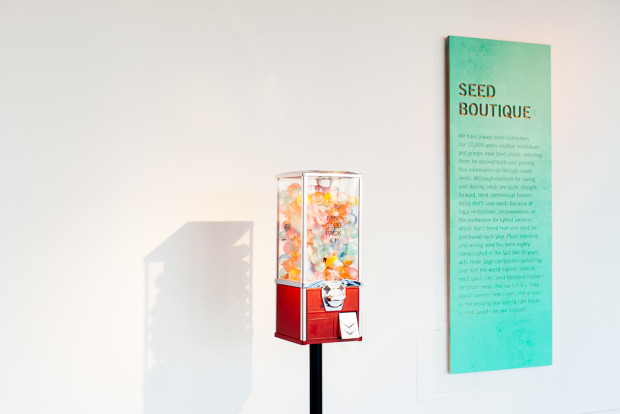The Seed Boutique features ten plant seeds that each tell a story about current seed issues.
We have always been biohackers. For 10,000 years creative individuals and groups have bred plants, selecting for desired traits and passing this information on through saved seeds. Although methods for saving and sharing seeds are quite straightforward, most commercial farmers today don’t save seeds because of legal restrictions, inconvenience, or the preference for hybrid varieties which don’t breed true and must be purchased each year. Plant breeding and selling seeds has been highly consolidated in the last twenty years, with three large companies controlling over half the world market share in seed sales.The Seed Boutique features ten plant seeds that each tell a story about current seed issues. Put a coin in the vending machine and help maintain the work of biohackers past.
The following seeds are available in the Seed Boutique:
OUTREDGEOUS LETTUCE
SELECTION: LANE SELMAN, DIRECTOR OF CULINARY BREEDING NETWORK (US)
It was only through a news article that Frank Morton of Wild Garden Seeds discovered that his Outredgeous Red Romaine Lettuce would become the first produce grown and eaten on the International Space Station. After testing a range of vegetables, NASA chose this red-leafed lettuce because it had the lowest level of microbial growth on the leaf. Frank Morton became a plant breeder after noticing a red lettuce amidst a field of green. Seeing this unexpected cross-pollination in his field in Oregon inspired him to try creating his own unique varieties. He now breeds more than two hundred varieties of lettuces. From tender to crunchy textures, his varieties are juicy and strikingly beautiful, showing off his love of contrasting colors and vivid patterns. Through the Culinary Breeding Network, Frank receives chef and consumer input that he incorporates into his breeding process. Which traits would you choose? Which two plants would you cross?
GEORGIAN FLAT-LEAF PARSLEY
SELECTION: LANE SELMAN, DIRECTOR OF CULINARY BREEDING NETWORK (US)
In 2012 Wild Garden Seeds embarked upon a parsley breeding project that started with fourteen different cultivars from ten different countries. The initial plan was to let the parleys cross-pollinate to produce a few quality varieties adapted to the region. Bringing the Culinary Breeding Network into the conversation changed the trajectory. Participating chefs were able to identify unique flavours in a few parsleys that made them distinct for use in the kitchen, resulting in the creation of more varieties than originally intended, in order to preserve meaningful flavours. The world is losing much of its agricultural genetic diversity, but there is still a fair amount of diversity to choose from when starting a plant breeding project. Our best chance for saving genetic diversity is finding desirable traits, and creating varieties adapted to our region and palates, and perpetuating them.
STOCKY GOLDEN ROASTER
SELECTION: LANE SELMAN, DIRECTOR OF CULINARY BREEDING NETWORK (US)
Many organic farmers rely on seed companies. But what happens when those companies stop selling what farmers want to grow? Several years ago, farmers couldn’t find seeds for ‘Gypsy’, a dependable sweet pepper variety they loved. Plant breeders created ‘Gypsy’ by crossing two inbred parents. Through this common process, their offspring, called hybrids, are very uniform and high yielding, which is great for farmers. However, once a company decides not to produce the hybrid anymore, it is gone for good. Any hybrid seeds that are saved and grown by the farmer will not produce a uniform pepper. Farmers needed a substitute sweet pepper, and they wanted one that was open-pollinated (OP), which means it comes from a long lineage of stable genetics from which anyone can save seeds. Luckily, plant breeder Frank Morton of Wild Garden Seed had created several promising OP varieties that ripen early for the short Oregon season and have phenomenal flavour and texture. His work created independance for farmers, who now have the tools they need in perpetuity. This is seed sovereignty.
ROSALINDA SUGAR BEET
SELECTION: KIRSTIE MCADOO, EDUCATION AND LEARNING CO-ORDINATOR OF AIRFIELD ESTATE (IE)
Sugar was first extracted from the white beet, a tuber descendent of the sea beet, by German chemist Andreas Marggraf in 1747. The discovery was welcomed by many in Europe, including Napoleon Bonaparte, as a way of being sugar self-sufficient. Ireland’s first sugar beet farm opened in County Carlow in 1926 and supplied sugar to the British Isles during a time when cane sugar was scarce. After the two world wars, cane sugar flooded the market and the demand for beet sugar fell. The Carlow factory closed in 2007. However, beet sugar can also be used as animal feed and in ethanol production, a petroleum alternative. With the removal of EU sugar beet quotas in 2017, Ireland may be welcoming back a once-familiar and very diverse crop.
TEMUCO QUINOA
SELECTION: IRISH SEED SAVERS ASSOCIATION, COUNTY CLARE (IE)
International research into the ancient South American staple began in the 1990s, led by NASA in its search for space station sustenance. Grown in the Andean region of South America for at least 3,000 years the pseudograin began being promoted as a miracle whole food with an impressive arsenal of amino acids. In the space of a decade, quinoa has gone from a low-yielding sustenance crop maintained by traditional small-scale farming in arid parts of Bolivia to a global commodity, sold as a luxury item in Lima, Peru and in health food shops worldwide. Quinoa’s hardiness and adaptability means that it can be grown in multiple climates, even one with as much rainfall as Ireland. Biodiversity of the grain has been maintained and nurtured by the traditional methods of Bolivian farming and 3,000 cultivars exist today, making it a strong crop for genetic research and crop security.
STORMONT CIRRUS LINSEED
SELECTION: IRISH SEED SAVERS ASSOCIATION, COUNTY CLARE (IE)
This variety of of Irish linseed was once stored in the Vavilov Institute of Plant Industry in Russia, one of the world’s first seedbanks. Founded in 1927 in Leningrad (now St. Petersburg) by geneticist and botanist Nikolai Vavilov, the survival of the seed bank was first put to the test by the outbreak of World War II. During the twenty-eight month Siege of Leningrad, the bank was guarded by a group of scientists. Seed saving was of such importance that, at the siege’s end, nine of the seed-guarding scientists had died of starvation instead of eating the seeds. The institute came under threat again in 2010, this time from the Russian Housing Development Foundation who wished to demolish the bank to make way for flats. However, in April 2012 the Russian government ruled in favour of the preservation of the rare genetic repository over private development interests.
FLOWER SPROUTS
SELECTION: CENTER FOR GENOMIC GASTRONOMY (US/NO/IE)
A Flower Sprout is a cross between kale and brussel sprouts. Launched in the autumn of 2014 by UK-based Tozer seeds, the flower sprout is described as a “brand new vegetable… which is versatile, easy to prepare and good looking”. Flower Sprouts are an example of contemporary crops that seem to have been bred for traits that would appeal to a very specific consumer demographic profile. The vegetable can be used in very small quantities, without too much food wastage, perfect for a single person living alone. Its colour and novel appearance appeal to novelty-seeking home chefs. In addition, health-centric news outlets have welcomed the crossbreeding of two healthfood stables.
BIODIVERSE GRASS SEED MIX
SELECTION: DR. TREVOR HODKINSON, HEAD OF BOTANY, TRINITY COLLEGE DUBLIN (IE)
This biodiverse grass seed mix is a combination of five different types of grass. With its strong dairy and meat industry and plentiful rainfall, Ireland can easily grow grass which is converted into animal products. So much so that approximately a third of Ireland’s greenhouse gas emissions come from the agricultural sector. There are plans to considerably increase the national herd of cattle and sheep, which emit methane gas, and would cause Ireland to not meet its targets for reducing agriculture emissions. Introducing a more biodiverse mix of grasses may make better use of nutrients in the soil and reduce waste fertiliser inputs. It may be a small first step to more radical changes, such as adding trees where sheep are grazing, reforestation and changing land use overall.
GM CORN
SELECTION: CENTER FOR GENOMIC GASTRONOMY (US/NO/IE)
When seeds are regarded as trade secrets that need to be protected, strange tales of industrial espionage emerge. In 2013, six Chinese citizens were indicted in Iowa on charges of plotting to steal GM seeds from Monsanto, DuPont and AgReliant Genetics. Mo Hailong, director of international business at Beijing Dabeinong Technology Group, was arrested after being spotted on his knees, digging in an Iowa cornfield. The indictment claims that three of the defendants attempted to ship over one hundred kilograms of corn seed, packaged in ziplock bags, from Illinois to Hong Kong. On another occasion, a defendant attempted to smuggle corn seed on a flight, concealing it in one hundred Subway® napkins within two boxes of Orville Redenbacher brand microwave popcorn. Seeds can be stolen in a number of ways: transplanting seedlings before they germinate, obtaining ears of corn, self-pollinating a hybrid, laboratory analysis, and employee leaks. Companies attempt to prevent theft of corn germplasm by delivering seed close to planting time in unmarked bags and not telling contract growers what they are growing.
BEEFY RESILIENT GREX BEAN
SELECTION: CENTER FOR GENOMIC GASTRONOMY (US/NO/IE)
2016 is the United Nations International Year of Pulses. A pulse is a crop harvested solely for the dry seed, like beans, peas and lentils. Pulses are high in protein, low in water consumption and are fixers of soil nitrogen. Whole nations exist and thrive on pulse-for-protein diets. Pulses are also food for our food; 25% of annual production is used for animal feed. This Beefy Resilient Grex Bean was an accidental discovery by Carol Deppe, a plant geneticist and breeder based in Oregon in the United State. An unlikely cross between two pure bean varieties, the result is a high-yield, hardy bean that ‘tastes more beefy than beef does’. This is also an Open Source Seed Initiative Pledged variety meaning that you have the right to use this seed however you want — breed with it, or even grow and sell the seed yourself. When you buy or accept this variety, however, you are agreeing to honour the OSSI Pledge.
